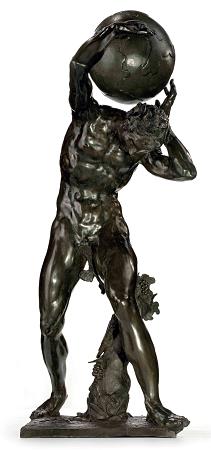
Adriaen de Vries. Adriaen de Vries was a Northern Mannerist sculptor born in the Netherlands but working in Central Europe, whose international style crossed the threshold to the Baroque; he excelled in refined modelling and bronze casting and in the manipulation of patina and became the most famous European sculptor of his generation.
He also excelled in draughtsmanship. Partly as a result of the disturbances of the Thirty Years' War, and also changes in style, Adriaen de Vries had no direct follower.
Born in The Hague to a patrician family, his early training is obscure; a recent suggestion suggests an apprenticeship with Willem Danielsz. van Tetrode, known in Italy as Guglielmo Fiammingo, a pupil of Benvenuto Cellini who had returned to the Netherlands.
Another possibility is that he was apprenticed to a goldsmith, his brother-in-law Simon Adriaensz Rottermont. Both possibilities are suggestive in view of de Vries' virtuoso casting technique and refined finish.
He travelled to Florence, where, as early as 1581, he is documented working in the studio of the master Mannerist sculptor Giambologna, a Northerner like himself, and the greatest influence on his mature work. Three of the Virtues and some of the putti for Giambologna's Grimaldi Chapel, in San Francesco di Castelletto, Genoa, have been attributed to Adriaen de Vries. In 1586 he was called to Milan to assist Pompeo, the son of the ailin
He also excelled in draughtsmanship. Partly as a result of the disturbances of the Thirty Years' War, and also changes in style, Adriaen de Vries had no direct follower.
Born in The Hague to a patrician family, his early training is obscure; a recent suggestion suggests an apprenticeship with Willem Danielsz. van Tetrode, known in Italy as Guglielmo Fiammingo, a pupil of Benvenuto Cellini who had returned to the Netherlands.
Another possibility is that he was apprenticed to a goldsmith, his brother-in-law Simon Adriaensz Rottermont. Both possibilities are suggestive in view of de Vries' virtuoso casting technique and refined finish.
He travelled to Florence, where, as early as 1581, he is documented working in the studio of the master Mannerist sculptor Giambologna, a Northerner like himself, and the greatest influence on his mature work. Three of the Virtues and some of the putti for Giambologna's Grimaldi Chapel, in San Francesco di Castelletto, Genoa, have been attributed to Adriaen de Vries. In 1586 he was called to Milan to assist Pompeo, the son of the ailin
Wikipedia ...